
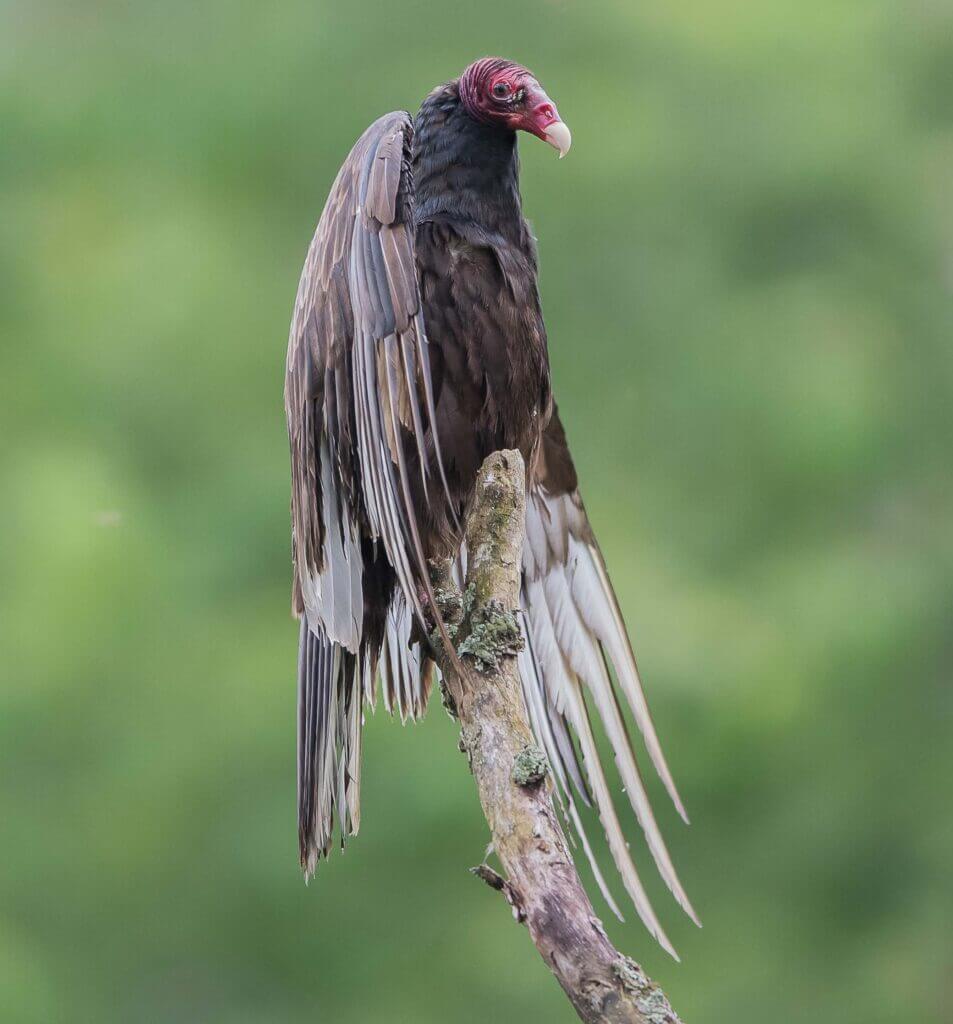
Home to 21 species, West Virginia is teeming with raptors.
This story was originally published in the January 2020 issue of Wonderful West Virginia. To subscribe, visit wonderfulwv.com.
written by Wendy Holdren
photographed by Charles Maurer
Tucked away inside the corners of rustic wooden barns or perched atop fence posts along the highway, birds of prey, also known as raptors, can be spotted in a variety of locations throughout West Virginia. They vary in size and in nesting preferences, and while some hunt and feed on vertebrates that are large relative to the hunter, other raptors have diets that are mostly invertebrates.
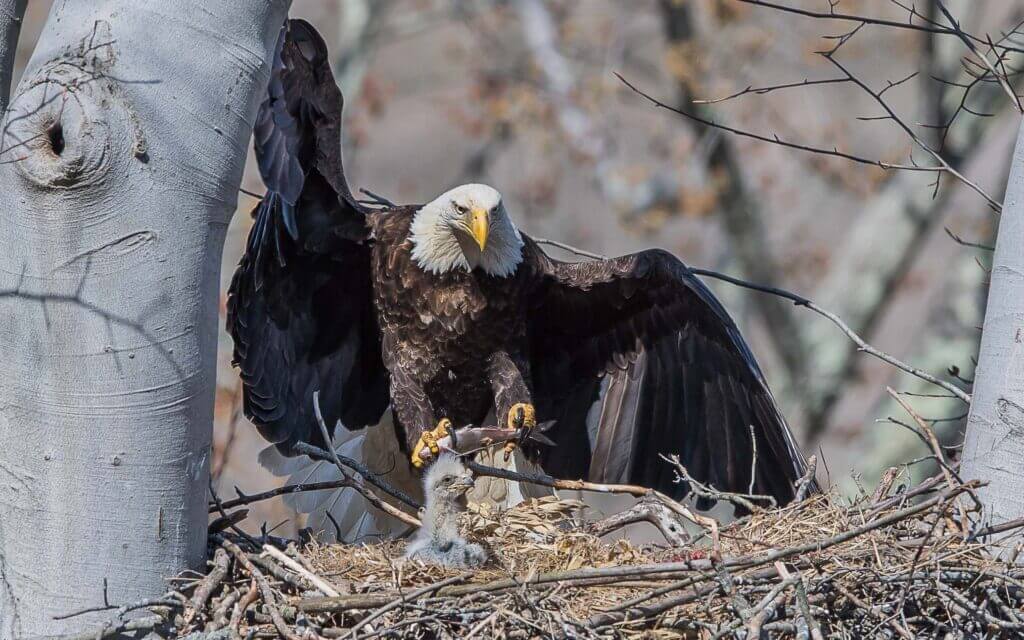
“We have two types of raptors: diurnal, meaning they are active during the day, and nocturnal, meaning they’re active at night,” explains Rich Bailey, State Ornithologist for the West Virginia Division of Natural Resources Wildlife Resources Section. In all, West Virginia is home to 21 breeding raptor species—15 diurnal and 6 nocturnal.
The Early Birds
Perhaps the best-known of the state’s diurnal species are hawks, eagles, and falcons. “We have six species of hawks that breed in this state, separated into two genera: Buteo and Accipiter,” Bailey says. The Buteo genus includes larger, soaring hawks, such as red-tailed hawks and red-shouldered hawks, while the Accipiter genus contains smaller, agile hawks, such as the Cooper’s hawk. Some hawks, like the red-tailed hawk, can often be spotted in open country.
Another well-known species in West Virginia is the bald eagle. The bald eagle has been increasing across its range following the banning of DDT, and the species was listed as federally endangered in 1978. The first bald eagle nest was spotted in West Virginia in 1981 along the South Branch of the Potomac River. Bailey says more than 100 bald eagle nests have been documented since then, and people continue to see more and more birds across the state.
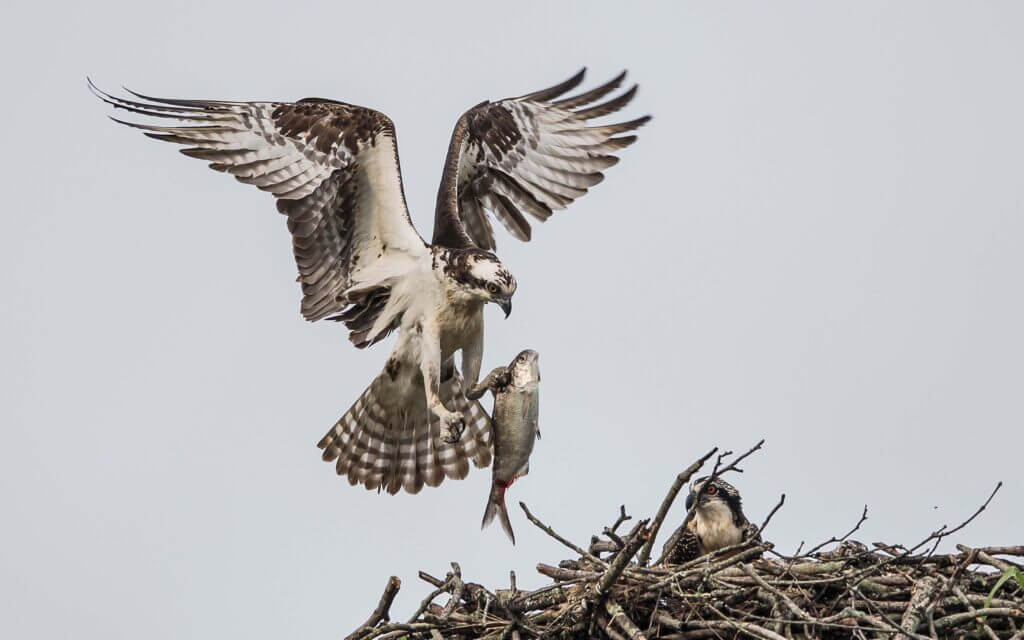
Another familiar diurnal family are falcons. West Virginia is home to three breeding species—peregrine falcons, American kestrels, and merlins. “Falcons have a distinctive shape,” Bailey says. “They have an angular shape to their wings. They’re built for speed.” The peregrine falcon, too, was once federally endangered. The bird was added to the endangered list in 1970 and recovered sufficiently for delisting by 1999, thanks to conservation initiatives. The New River Gorge National River hosted a restoration project in which young birds were taken from nests built on bridges in Virginia, New Jersey, and Maryland according to the DNR website.
“Peregrine falcons can dive in pursuit of other birds at tremendous speeds,” Bailey says, “while American kestrels dine on smaller prey, such as insects and rodents. Merlins, like peregrine falcons, often take avian prey.” Merlins have been increasing in population in the northeast, he says. The expansion of breeding includes West Virginia, where they have recently been documented in Elkins, nesting in a Norway spruce, and in Canaan Valley.
Another diurnal species is the osprey, sometimes called the “fish hawk,” as it is entirely specialized in catching fish. “If you want to see nesting osprey,” Bailey says, “the best place is Stonewall Jackson Lake in Lewis County. You can see them dive down to the water to catch fish.” Like the bald eagle, the osprey population is also increasing in West Virginia.
Ospreys frequently nest on platforms in open water, if they’re available. “In the Charleston area, along the Kanawha River, there’s an increasing number of nests on the tops of communications towers,” Bailey says, “which can prove troublesome to cellular phone tower operators.” All native raptors are protected under federal law, so it is illegal for tower operators to do anything to harass or harm the species. The U.S. Fish and Wildlife Service can give permits in special circumstances, such as allowing tower operators to remove osprey nests during the non-breeding season.
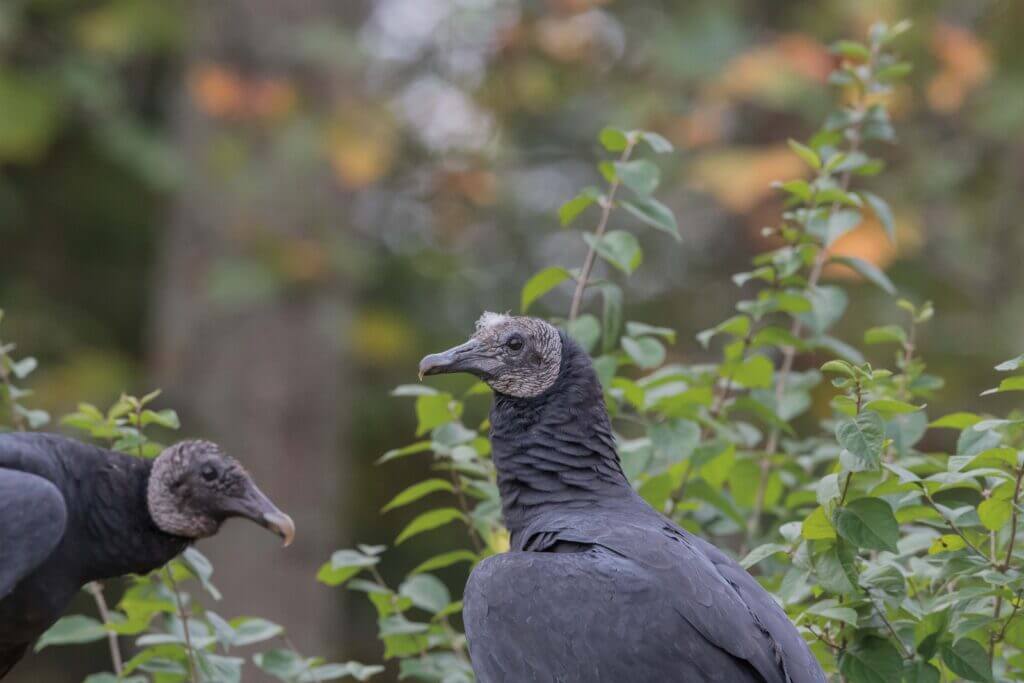
photographed by Jim Fregonara
Like the osprey, the northern harrier is sometimes known by its nickname, the “marsh hawk.” Bailey says there is only one place where the northern harrier is currently breeding—Canaan Valley. “They hunt and forage over shrubby, grassy wetlands and fields,” Bailey says. “You can see them cruising low over the ground for prey, such as rodents.” Harriers are more commonly spotted in West Virginia in winter months, as the species migrates from more northern latitudes for winter. During winter, they can be spotted in the Greenbrier Valley, near farm fields and agricultural areas as well as in other open areas.
In 2019, the first known breeding of a Mississippi kite in the state was documented in Putnam County. While the bird typically breeds in southern states, Bailey says it occasionally nests farther north. The species often feasts on large insects, such as grasshoppers.
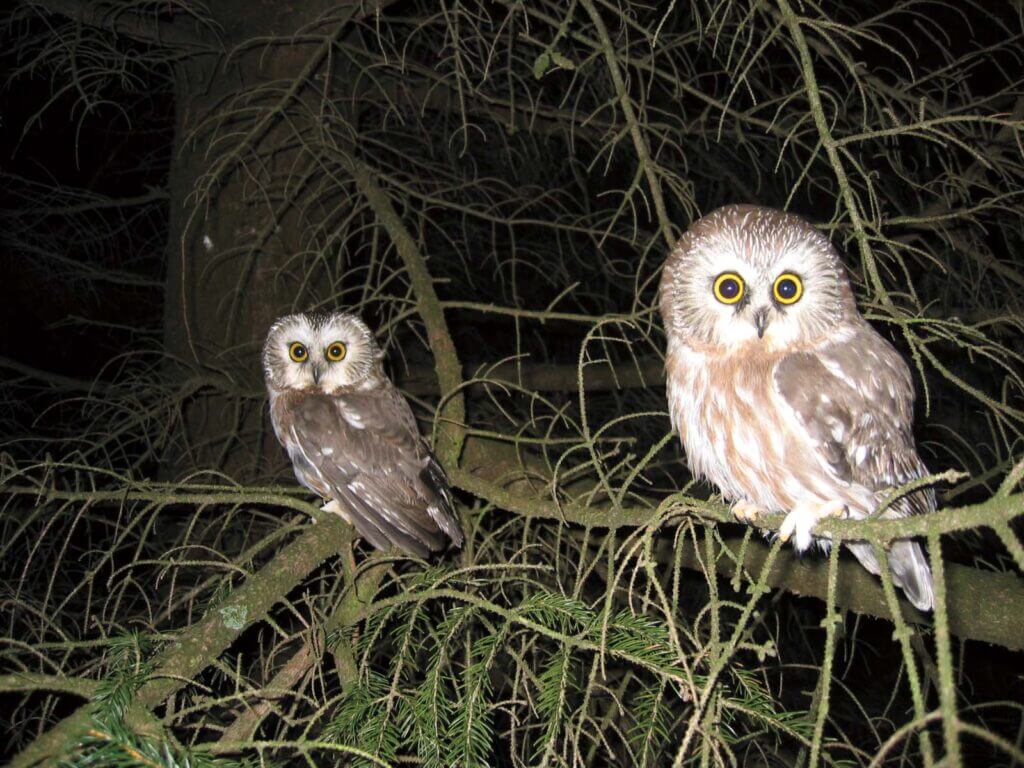
photographed by Jim Fregonara
Perhaps the most well-known of scavenging birds are vultures. West Virginia is home to two species: the turkey vulture and the black vulture. While the two species are similar, they have several unique identifiers. Both species have featherless heads, but the adult turkey vulture’s head is pink and the black vulture’s is, of course, black. The two species can also be identified by their wings as they soar. The trailing undersides of a turkey vulture’s wings are a lighter color, while the black vulture is all dark, except its wingtips, which are white.
The turkey vulture has a great sense of smell, but the black vulture does not. Turkey vultures can smell carrion—decaying flesh—so black vultures fly high and keep a close eye on the turkey vultures, which signal where to find their next meal. “Black vultures are more aggressive,” Bailey says. “They will kick turkey vultures off carcasses, and they will occasionally take some live prey.”
He says there is increasing conflict between farmers and black vultures, as the farmers are concerned about predation of young livestock. This is especially true in the Eastern Panhandle, where black vultures are most abundant. The United States Department of Agriculture’s Wildlife Services is working with landowners to find solutions.
The Night Owls
Six species of raptors hunt at night in West Virginia, all of them owls. The largest is the great horned owl, well-known for its bright yellow eyes and earlike tufts. While beautiful for birdwatchers, the great horned owl is a powerful avian predator, Bailey says, able to tackle prey as large as a skunk. These owls tend to nest in valleys and surrounding hills, often in woods near open country. They are one of the earliest-breeding raptors and can begin nesting in December.
Another species, a bit smaller than the great horned owl, is the barred owl. The species, a mottled gray-brown color, prefers forests and woods. These birds have dark eyes and are oftentimes called “hoot owls” in West Virginia for their characteristic calls. Barred owls feed on rodents and will even catch crayfish from streams.
Smaller still is the eastern screech-owl. In West Virginia, this bird prefers to nest in woods interspersed with fields or other open areas, its primary hunting grounds. Bailey says these owls superficially appear like miniature great horned owls, with small tufts atop their heads.
The other three native West Virginia species are less common: the barn owl, the northern saw-whet owl, and the long-eared owl. Named for its frequent use of human-built structures for nesting and roosting, the barn owl has a distinctive, heart-shaped white face with small, dark eyes. Although large barns are favorite haunts, barn owls also nest in bell towers, attics, vent pipes, and more. “We don’t have a good sense of the barn owl population in the state, aside from that it’s less than what it once was,” Bailey says. “There are signs of them in farm country, like the Greenbrier Valley, as they leave pellets (from digested prey) in structures where they roost or nest.”
The northern saw-whet is a tiny owl, usually preferring the highlands and spruce forests for nesting. Bailey says these birds like to breed in places like the headwaters of Otter Creek Wilderness, but they’ve recently been found as far south in the state as Camp Creek State Park and Forest. And finally there’s the long-eared owl, which Bailey says is one of the most enigmatic birds in North America. There’s no practical way to survey for these owls, as their habitats are widely varied and their presence is sporadic.
Threats to the Species
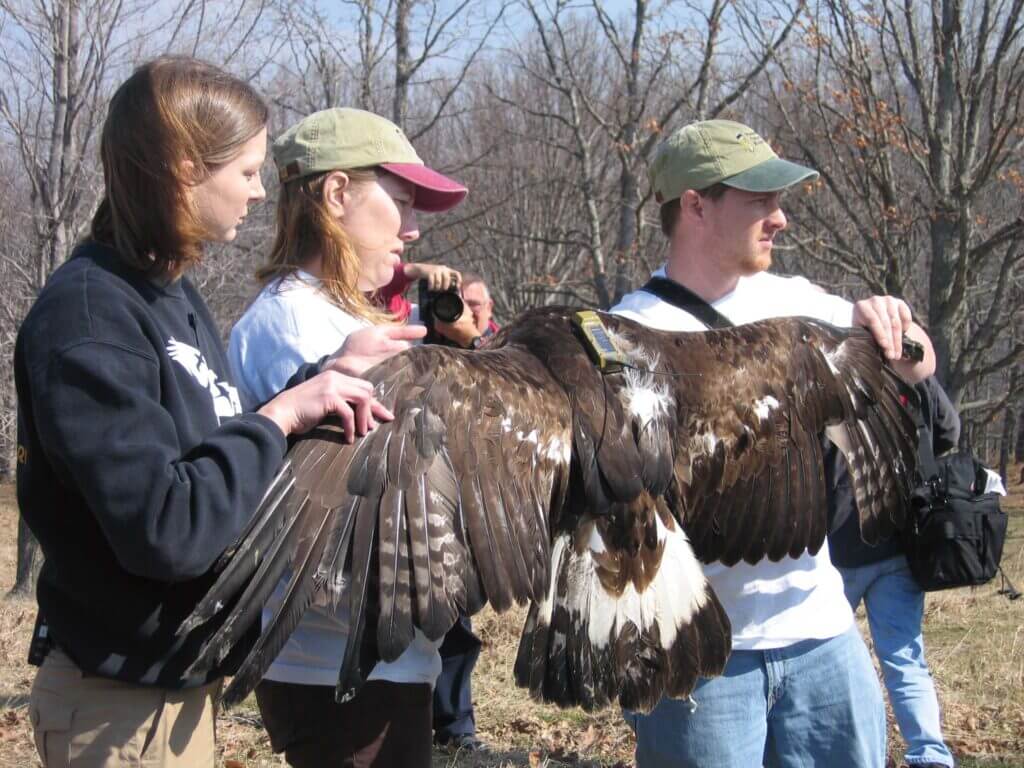
As formidable as they are, hawks and eagles suffer a number of threats. “Every year, people illegally shoot red-tailed hawks. Farmers who are concerned about their poultry or livestock occasionally shoot them. Sometimes they get caught in snares or harmed accidentally,” Bailey says. “But one thing is easily preventable—poisoning from accidental ingestion of lead-based ammunition.”
Lead-based ammunition is legal in West Virginia, but it is illegal when shooting waterfowl because it can negatively impact wildlife, especially scavenging birds that feed on entrails of hunters’ kills that may be embedded with lead fragments. Jesse Fallon, director of veterinary medicine at the Avian Conservation Center of Appalachia, says he sees lead poisoning fairly regularly in turkey vultures, black vultures, and eagles.
“It’s the second most common reason for admittance for bald eagles,” Fallon says. The first most common is trauma, such as being hit by a car.
Raptors that have been lead poisoned appear weak and uncoordinated and often lose the ability to fly. In severe cases, Fallon says, birds may be completely unable to rise, and their condition may progress to seizures. When birds are admitted at the Avian Conservation Center, volunteer veterinarians perform physical exams, conduct X-rays, and administer blood tests. If the results show lead poisoning, supportive care begins. The birds receive hydration to help move lead out of the bloodstream. They also receive nutritional support, as they are likely unable to feed themselves. Finally, they receive chelation therapy, which further helps remove lead from the bloodstream through the kidneys. “Some birds can have a full recovery,” Fallon says. “But some, even with aggressive therapy, cannot be recovered.”
Even a couple-millimeter piece of lead is enough to cause toxicity in an eagle, Fallon says. Humans are vulnerable, too: Low lead exposure can affect neurological development in children. “If you’re a hunter feeding your family, it’s safer for everyone to use non-lead ammunition,” Fallon says. Bailey agrees, “As an agency, the WV DNR is pro-hunting. But at the same time, for those who are interested in having a positive impact on birds of prey, using non-lead-based ammo can be a great option.”
Anyone who encounters an injured bird can call a 24-hour hotline at 304.906.5438 for assistance. To safely transport an injured bird, Fallon recommends using a jacket or towel to pick it up, then placing it in a cardboard box to protect its wings. DNR conservation officers can also be reached to coordinate a transport.
To learn more about raptors, including how to help improve their habitats, visit the West Virginia DNR website or contact your local DNR office. Also, look for Rich Bailey’s upcoming book, the Second Atlas of the Breeding Birds in West Virginia, with an anticipated release year of 2021, and which will feature 171 breeding bird species native to the Mountain State.











